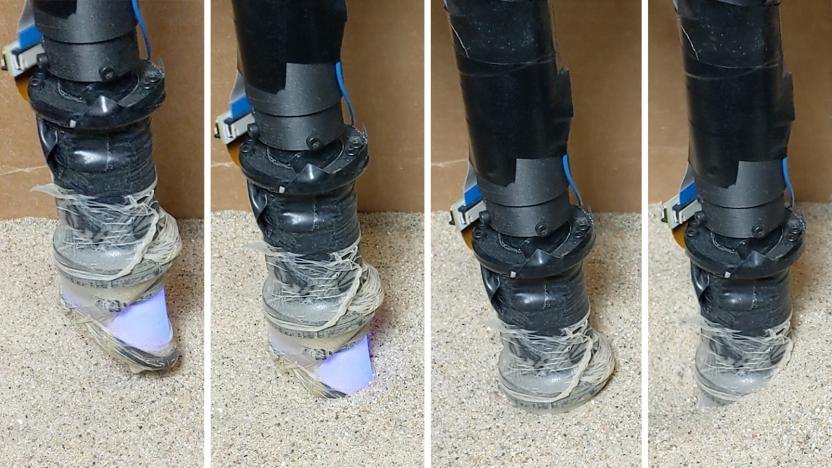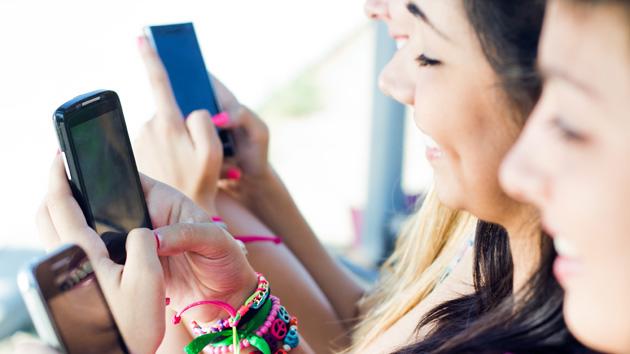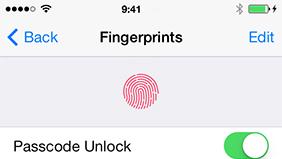finger
Latest

Robotic 'digger finger' could search for buried land mines
Researchers have built a robot 'finger' that can dig through sand to find buried items like land mines and cables.

Horrifying finger attachment lets your phone touch you back
Have you ever wished your phone could tap you when you had a notification, drag itself over to you on its own or touch you back? No? Too bad. Researchers in France have developed a finger-like phone and tablet attachment that can do all of those things and more. Called MobiLimb, it's made up of five servo motors, an Arduino microcontroller and a sensor, and it can do a number of unsettling things that are straight out of nightmares.

Microsoft Office iPhone users can doodle with their fingers
If you want to sketch or perhaps add your signature to a Word, Excel or PowerPoint document on iOS, the only option has been to use the iPad Pro's Pencil. Now, with the latest version of Office for the iPhone, you can draw directly on a document with no need for the stylus. Once you launch the app, you can "use your finger to write, draw and highlight with the tools in the new Draw tab," Microsoft says.

The NSA wants to identify phone users by their finger swipes
For the National Security Agency, the fingerprint reader on your smartphone just isn't secure enough. Lockheed Martin has confirmed to Nextgov that the intelligence outfit is testing Mandrake, an identification system that verifies who you are based on the way you swipe your finger across the screen. The technology measures not only the shape of your movements, but the acceleration and speed. It can tell whether you draw in broad, fast strokes or tend to be cautious. Lockheed doesn't know whether or not the NSA is deploying Mandrake in the field, but it wouldn't be shocking. Given that it's possible to fake fingerprints, gesture-based authentication may the best way of proving that the right person really is present.

Fujitsu's ring lets you write in the air with your fingertip
Head-mounted displays are frequently supposed to keep your hands free, but they only sometimes live up to that promise. You can't really dictate a message in a noisy warehouse, can you? If Fujitsu gets its way, you won't have to. It just built a smart ring that not only allows for motion control (something we've seen before), but in-air handwriting. All you do is trace letters with your fingertip, and the motion sensor translates those scribbles into usable characters -- supremely helpful if you need to send a quick reply when you don't have access to a keyboard. There's an NFC tag reader in the ring, too, so you can get instructions for working on a device just by tapping it.

You only need a camera (and luck) to copy someone's fingerprints
Forget having to lift smudges from a touchscreen to copy someone's fingerprints. According to a Chaos Computer Club presentation, you only need a camera... well, that and a little luck. The hacking association's Jan Krissler recently demonstrated that you can reproduce someone's fingerprint by getting a few good photos of their hand and processing it through off-the-shelf authentication software like VeriFinger. In Kessler's case, he got the German Defense Minister's thumbprint through photos from a press conference.

Your smartphone is changing the way your fingers work
Your smartphone is changing more than just your habits -- it's changing the way your hands work, too. Swiss researchers have discovered that activity in the brain's cortex associated with index fingers and thumbs is enhanced directly in proportion to how often you use your phone's touchscreen. That area of your mind will light up if you message your friends all week, but it'll fade the longer you spend away from your device. People with basic cellphones don't see this, according to the scientists. This suggests that repetitive smartphone use is altering your sensory processing, and that your brain is perceiving your digits in a different way. Whether or not that's a good thing is still up in the air, but it shows that you don't have to be in a profession driven by hand dexterity (such as music) to see a shift in how your brain and fingers work together. [Image credit: Shutterstock / nenetus]

The Galaxy S5's fingerprint reader can be fooled by fake digits
It looks like the iPhone 5s isn't the only smartphone whose fingerprint reader can be fooled by fake digits. SR Labs has just posted a video (shown below) showing that Samsung's just-launched Galaxy S5 is susceptible to the same trick: as long as you have a good photo of a latent print (such as one from the touchscreen), you can create a mold that passes for a real finger. The lab also claims that Samsung's approach may ultimately be less secure than Apple's, since you're not forced to enter a passcode under certain conditions (such as a reboot) and can use the fingerprint to make PayPal transactions.

Samsung's 2014 smart TVs will let you control videos by pointing your finger
Samsung's 2014 smart TV lineup may revolve around impressive-looking hardware, but the Korean tech giant has revealed that interface improvements will also play an important role. Its new TVs will support finger gestures that should be more intuitive than the whole-hand commands of this year's models; you can stop a movie with a spinning motion, for instance. Voice control will also be more powerful. It's at last possible to change channels or launch apps with a single step, and search results appear in one place. While the gesture and voice upgrades may not be revolutions, they'll likely be welcome to viewers frustrated with unwieldy TV software.

Find which fingerprint is associated with Apple ID
Jeff Gamet at The Mac Observer posted a very helpful article today on how to identify which of your 10 fingers are linked to your Touch ID on your new iPhone 5s. He walks through the six steps necessary to differentiate which of the saved five fingers you use as your passcode. (You did use a finger, didn't you?) One caveat to this post though: You can "assign custom names to each fingerprint" by opening the Fingerprints screen, then tapping edit and tapping the name, which is listed as Finger 1 through Finger 5. Choose the one you want to rename and type away. This part of the tip is offered by The Mac Observer reader Nik Jones and tweeted by @mcelhern (Kirk McElhern). Thanks guys! If you need help setting up the Touch ID on your new iPhone 5s, Apple support has just the document you can read, iPhone 5s: Using Touch ID.

Akimbo Kinect hack offers precise control with minimal effort (video)
We've seen Microsoft's Kinect used in countless ways, but 3Gear Systems means to better these predecessors with the beta release of its SDK, which turns all the subtleties of hand movement into actions. In addition to using two Kinect cameras for accuracy, the software compares hand poses against a pre-rendered database so gesture commands are executed with little lag. It offers complete control of a virtual 3D environment from the comfort of your natural desk position, so you won't have to worry about flail fatigue after long stints. A free public beta is available now until November 30th, at which point bigger companies will require a license, while individuals and small enterprises will continue to get complimentary access. We know what you're thinking -- it's just another Kinect hack -- but we suggest you reserve judgment til you've seen the demo below, showing examples of how the API could be used for CAD, medical, and of course, gaming applications.

Touch Bionics releases new prosthetic fingers, flips the old ones the bird
The only upgrades available for our puny human hands are gaming controller calluses, but if you're sporting an i-LIMB digits hand prosthesis, you can now grab a set of improved fingers. Touch Bionics' "smaller, lighter and more anatomically accurate" appendages are now available worldwide, as well as a new wrist-band unit which houses all the necessary computing power and juice for their function. Best of all, these developments allow more people to adopt the tech than the previous generation, including those with more petite hands or finger amputations closer to the knuckle. We don't know how much it'll cost for a fresh set, but we'll let health agencies and insurance companies deal with that part. With these upgrades and RSL Steeper's latest offering, it won't be long before our flesh-based variants are meager in comparison.

Ringbow hits Kickstarter, promises directional pad-assisted touch gaming
When we first saw the Ringbow finger peripheral, it was a gangly prototype, tethered to an external battery -- not exactly ideal for a portable tablet accessory. The idea is to strap a D-pad to a user's finger, netting them extra control for touch-based games. Now the duo behind the device is showcasing a self-contained unit on Kickstarter, hoping to garner enough interest to send it off to production. The Bluetooth-compatible band boasts an adjustable one-size-fits-all grip, a nine-way directional nub and a five hour battery life. A $45 contribution buys a standard black Ringbow and a game package, though more generous backers can score additional colors, exclusive hardware and dev kits. Without $100,000 in support, however, the ring won't be minted. Follow the links below if you're compelled to fund the digital circlet.

Touch pad prototype works without movement, makes fingertips feel like they're sliding (video)
This comes from the same touchy-feely Kajimoto lab in Japan that brought us the tactile kiss transmission device and we totally see where they're going with it: maximum sensation, minimum effort. You only have to exert the gentlest of pressures on this prototype touch pad and it zaps your fingertip with little electrical signals, mimicking the feeling of sliding your finger over a surface. We imagine it's a bit like the little red pointing stick in the middle of a Lenovo ThinkPad keyboard, for example, but with the addition of "position-dependent data input" to create the illusion that your finger is actually touching different areas of the screen. For now though, if you don't mind stretching a finger to your old-stylee mouse or trackpad, then check out the video after the break.

iPad finger ripper suspect behind bars
It was a gruesome and sad story. After Bill Jordan picked up an iPad for a friend from the Cherry Creek Shopping Center Apple Store in Colorado, he was assaulted by two men who stole the iPad -- and in the process damaged his pinky finger so badly that part of it had to be removed. Now, the Denver Post is reporting that police have one of the suspects behind bars. Brandon Darnell Smith was arrested without incident and is being held in connection with the investigation into the assault and robbery of Jordan. The arrest came one day after Smith was identified in the theft, and the police asked the public for help in finding him. This particularly violent iPad theft has made national news and even ended up on one of David Letterman's Top Ten lists.

Thieves steal iPad, finger
Ugh, this is a grisly one -- Bill Jordan picked up an iPad for someone else the other day from an Apple Store in a Colorado mall near him, and as he walked away, some thieves grabbed his bag away so quickly that it took part of his finger off. Scary stuff -- apparently two young men followed him out of the store down to the parking garage, jumped him and grabbed the bag. There was a scuffle which Jordan's pinky finger didn't survive. After rushing off to a hospital, he was told part of the finger had to come off. We've heard of thieves targeting Apple Store customers before, and especially since the iPad is such a hot commodity, those bags can unfortunately make a big target. Be careful out there. Two videos (both in Flash, unfortunately -- sorry about that) on the robbery after the link below. [via Engadget]

8-bit hanger is a gravity-defying, geek-gratifying implement of mass distraction
What's this you say, your clothes would be better off if they weren't strewn all over the floor, but you just don't know how to maintain them airborne sans magical abilities? Fear not, we've finally found a hanger worthy of a true gadget geek in the retro styled 8-bit pointer you see above. There's not an overwhelming amount of complexity to it -- hell, even the one screw that holds the finger to the wall is permanently attached -- but nothing communicates your tech credentials quite like a pixelated mouse cursor from yesteryear. Available now for $19.99 a piece plus shipping.

iPad devsugar: Three lessons from the iPhone
In pixel-terms, the iPad offers a much larger workspace to develop on than the iPhone but in terms of the human experience, it's not that very far away from iPhone programming. The two share an underlying operating system and a large overlap in human interaction realities. Here are just three of those overlapping iPhone development realities. Consider taking these ideas into account as you're building your new and updated applications for the iPad. Human fingers are big. Although the iPhone has a much smaller screen than the iPad, the size and shape of the typical human finger does not change between the two devices. Do not design interaction elements for the iPad smaller than, say 40-by-40 pixels in size. When in doubt, design larger rather than smaller. The iPad with its larger screen is more likely to be held further away during use than the iPhone, which is often raised fairly close in during use. Build your on-screen objects accordingly. With its 1024x768-pixel screen, the iPad has the room for clean, large interaction elements. Use that space to better compliment the human finger. Attention spans are short. Like the iPhone, expect your users to approach the iPad in a sporadic netbook-style fashion. Design your applications around short interaction periods and prepare for your application to be cut off as a user stands up to grab his next Orange-Cranberry Frapaccino. Always save your application state between sessions, as much as you possibly can. A well designed app should relaunch quickly and, upon relaunching, approximate the same task your user was performing the last time the program was run. This can demand diligence on the part of the programmer, but is worth the time investment due to the payoff in user satisfaction. One more tip after the break! Thanks Scott Lawrence, |Agent

Apple's patent application for pen-based computer remembers fingers can't write
Uh, um, ok... remember how Steve Jobs called the finger, the "best pointing device in the world" while chiding the stylus? Well, guess he wasn't lumping handwriting capabilities in with his lambasting if there's anything to this patent application for recognizing and processing "ink information" from a pen-based computer system that went public today (filed in July 2009). Naturally, the patent app makes liberal mention of tablets as the most recognizable pen-based computing systems; something that will certainly fuel speculation about the much rumored (it is still a rumor right?) Apple tablet possibly sporting a, gulp, stylus. Now go ahead and check the video after the break and listen to Steve Jobs describe the insanely great "pointing device we're all born with" (1:54) in addition to how Apple "invented a new technology called multi-touch" (2:03) with the patents to prove it (2:27 and 6:19). Oh MacWorld 2007, isn't there anything you can't do?

Nokia interface patent fits like an AR-enhancing glove
Okay, you know the drill by now: just because it's in a patent doesn't mean it's happening anytime soon, if ever. With that said, we'd love to see what Nokia had in mind when they concocted this one. As Unwired View recently unearthed, the Finnish phone maker has drawn up a design doc / patent application for comfortable, stretchable material that fits over your skin and is used for device interaction. Gestures and stretches are computed and signaled into nearby computers, phones, or interestingly enough "near-eye displays" -- sounds like we're getting into a bit of virtual / augmented reality territory here -- and they are also tailored to provide feedback via vibration. Again, don't hold your breath on seeing this come to fruition any point in the near (or even long) future, but still, we know what you're thinking: Nokia's gonna have to think of a ton of kooky color descriptions to accentuate any future lineup of input wristbands / fingerbands.[Via Pocket-lint]






